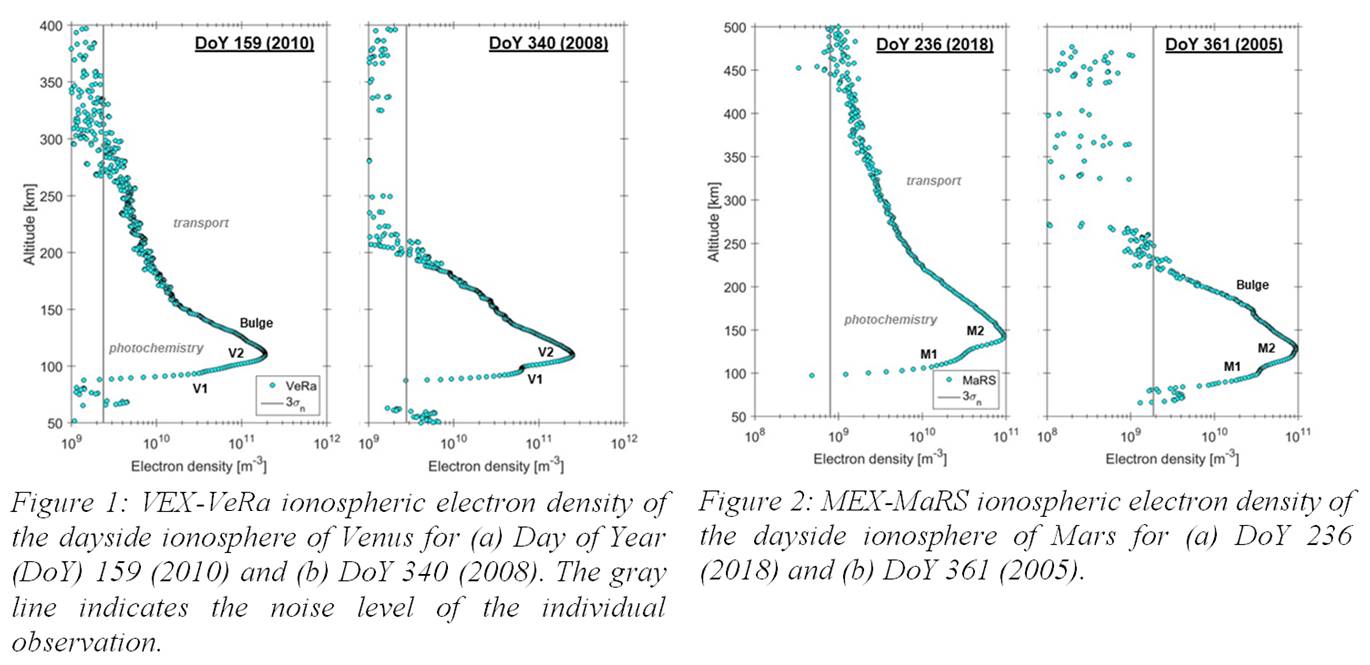- 1Rhenish Institute for Environmental Research, Cologne, Germany, (Kerstin.Peter@uni-koeln.de)
- 2Physics Division, Los Alamos National Laboratory, Los Alamos, USA (fchu@lanl.gov)
- 3Laboratory for Atmospheric and Space Physics, University of Colorado, Boulder, USA (robin.ramstad@lasp.colorado.edu, Ed.Thiemann@lasp.colorado.edu)
- 4Max Planck Institut für Sonnensystemforschung, Göttingen, Germany (fraenz@mps.mpg.de)
- 5Department of Physics and Astronomy, University of Iowa, Iowa, USA (zachary-girazian@uiowa.edu)
- 6Astronomical Applications Dept., United States Naval Observatory, Washington, DC, USA (ajkopf@gmail.com)
- 7Universität der Bundeswehr München, Neubiberg, Germany (Bernd.Haeusler@unibw.de)
- 8Swedish Institute of Space Physics, Kiruna, Sweden (futaana@irf.se, mats.holmstrom@irf.se
While the orbital and environmental parameters (e.g. orbit-Sun-distance, planetary mass/diameter, rotation rate, surface pressure) of Venus and Mars are very different, their planetary ionospheres show many similarities. The photochemically dominated regions of the undisturbed dayside ionospheres of Venus (Figure 1) and Mars (Figure 2) contain two major features: The ionospheric main peak (V2 at Venus and M2 at Mars) both originate from photoionization by solar EUV radiation, while the weaker secondary V1/M1 region is based on the primary and secondary ionization by solar X-ray radiation [1]. The upper region of the Venus and Mars dayside ionospheres is dominated by transport processes. The extent and shape of these regions in Venus Express Radio Science (VEX-VeRa) and Mars Express Radio Science (MEX-MaRS) observations is highly variable on temporal scales and ranges from an undisturbed exponential decay (Figure 1a and 2a) to strongly compressed shapes (Figure 1b and 2b).
In this work, 9 years of VEX-VeRa (2006-2014) and 18 years of MEX-MaRS (2004-ongoing) radio science observations are used to study the behavior of the upper ionospheric region of Venus and Mars. The identified parameters will be compared to other characteristics of the solar wind interaction region of both planets identified by Venus Express [2], Mars Express [3] and MAVEN [4] to improve our understanding of the solar wind interaction of planets without a global magnetic field. The effect of potential drivers on the temporal variability of the upper ionosphere are investigated for Venus and Mars by comparison with pristine solar wind parameters (e.g. VEX-ASPERA4 [5], MEX-ASPERA3 [6]) and solar radiation fluxes (FISM-V2 model [7], MAVEN EUV monitor [8]).

References
[1] Fox et al. (1996) Adv. Space Res., 17 (11).
[2] Titov et al. (2006) Cosmic Research 44 (4).
[3] Fletcher (2004) Mars Express. The scientific payload. ESA.
[4] Jakosky B. M. et al. (2015) SSR, 195, 3-48.
[5] Barabash et al. (2007) PSS, 55 (12).
[6] Barabash et al. (2006) SSR, 126, 113-164.
[7] Chamberlin et al. (2020) Space Weather, 18 (12).
[8] Thiemann et al. (2017) JGR Space Phys., 122 (3).
How to cite: Peter, K., Pätzold, M., Chu, F., Ramstad, R., Thiemann, E., Fränz, M., Girazian, Z., Kopf, A., Tellmann, S., Häusler, B., Futaana, Y., and Holmström, M.: The variability of the topside ionospheres of Venus and Mars in light of radio science observations, Europlanet Science Congress 2022, Granada, Spain, 18–23 Sep 2022, EPSC2022-857, https://doi.org/10.5194/epsc2022-857, 2022.

